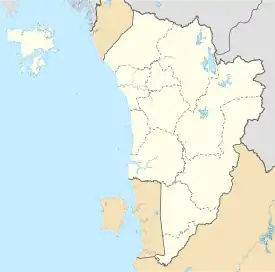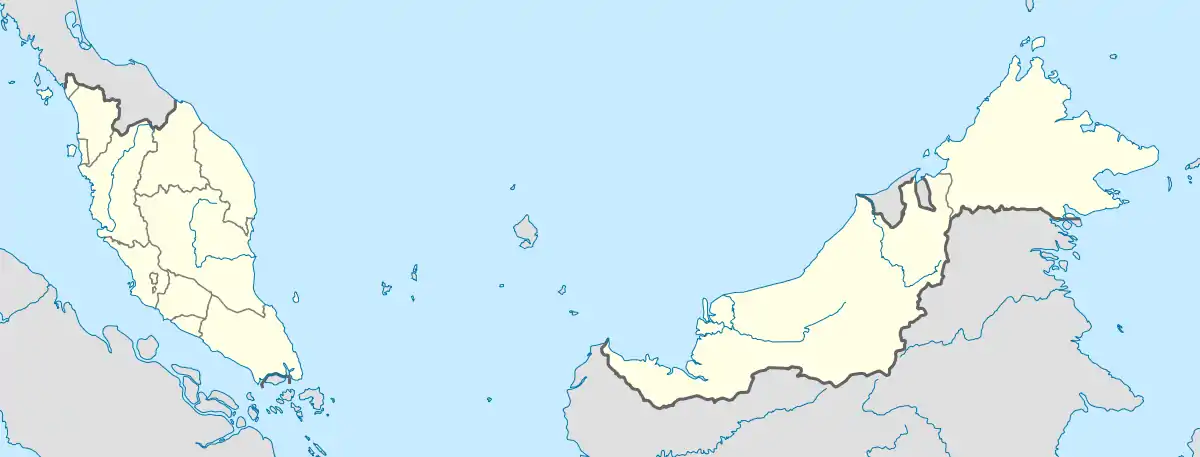Alor Setar
Alor Setar (Jawi: الور ستار), known as Alor Star from 2004 to 2008,[2] is the state capital of Kedah, Malaysia.[3] It is the second-largest city in the state after Sungai Petani and one of the most-important cities on the west coast of Peninsular Malaysia.[4] It sits along the country's longest expressway, located 400 km (250 mi) from Kuala Lumpur and 79 km (49 mi) north of George Town, Penang. The city is home to the Central State Administration Centre and is the administrative centre of Kota Setar District.
Alor Setar | |
|---|---|
City and state capital | |
| City of Alor Setar Bandaraya Alor Setar | |
| Other transcription(s) | |
| • Jawi | الور ستار |
| • Chinese | 亚罗士打 (Simplified) 亞羅士打 (Traditional) |
| • Tamil | அலோர் சேதார் |
From top, left to right: Zahir Mosque, Istana Anak Bukit, Alor Setar old railway station, Kedah State Art Gallery, Alor Setar Tower, and the fort at Kuala Kedah | |
 Flag 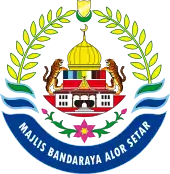 Seal | |
| Motto(s): Bandaraya warisan dalam taman "Heritage city in the garden" | |
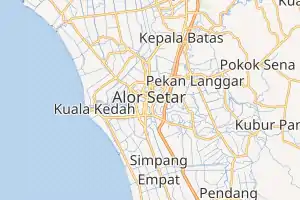
Location of Alor Setar in Kedah | |
| Coordinates: 06°07′06″N 100°22′10″E | |
| Country | |
| State | |
| District | Kota Setar |
| Establishment | 1735 |
| State capital status | 24 May 1888 |
| Municipality status | 1 February 1978 |
| City status | 21 December 2003 |
| Founded by | Sultan Muhammad Jiwa Zainal Adilin II |
| Government | |
| • Mayor | Mohd Zohdi Saad |
| Area | |
| • Total | 666.0 km2 (257.14 sq mi) |
| Elevation | 7 m (23 ft) |
| Population (2010)[1] | |
| • Total | 405,523 |
| • Density | 608.89/km2 (1,577.0/sq mi) |
| Demonym(s) | Alor Setarian |
| Time zone | UTC+8 (MST) |
| • Summer (DST) | Not observed |
| Postal code | 05xxx |
| International dialling code prefix | +6047 (landline only) |
| Website | www |
Its location along the main travel route from Malaysia to Thailand has long made it a major transportation hub in the northern Malay Peninsula. At present, the city covers a land area of 666 km2 (257 sq mi), which is occupied by more than 300,000 inhabitants (as per the 2010 census). At the local-government level, Alor Setar is administered by the Alor Setar City Council.[5]
Alor Setar is the birthplace of two Malaysian prime ministers, YTM Tunku Abdul Rahman[6] and Tun Dr. Mahathir bin Mohamad.[7]
Name
The name came from the combination of two Malay words: Alor ("small stream") and Setar (Bouea macrophylla Griff.; known as the marian plum, gandaria, or plum mango), a tree which is related to mango.[8]
The city's name was changed to Alor Star during a 21 December 2003 ceremony proclaiming it a city. The city's previous name was restored on 15 January 2009.[2]
History
Alor Setar was founded in 1735 by Kedah's 19th Ruler, Sultan Muhammad Jiwa Zainal Adilin II and was the state's eighth administrative centre since the establishment of the Kedah Sultanate in 1136.[9] The earlier administrative centres were located in Kota Bukit Meriam, Kota Sungai Emas, Kota Siputeh, Kota Naga, Kota Sena, Kota Indera Kayangan and Kota Bukit Pinang.[10]
Significant events held in Alor Setar include the returning of Perlis and Setul (now Satun) to Kedah by the Siamese in May 1897 (both provinces had been separated from Kedah in 1821) and a 90-day festival from June to September in 1904 to celebrate the wedding of the five children of Sultan Abdul Hamid Halim Shah.[11]
Alor Setar was proclaimed a city – the ninth in Malaysia – on 21 December 2003. A ceremony was held at Dataran Tunku, Alor Setar, attended by the Kedah's Sultan Tuanku Abdul Halim Mu'adzam Shah, his consort Che' Puan Haminah Hamidun, the heir apparent, other royalty and politicians.[12]
Geography
Alor Setar is located in the north-western part of Peninsular Malaysia, at the edge of the Malacca Strait which separates Malaysia from Indonesia. The Kota Setar district includes Alor Setar, and borders the districts of Kubang Pasu, Pokok Sena and Pendang.
The city encompasses an area of 666 km2 (257 sq mi), including the neighbouring district of Pokok Sena which falls under the jurisdiction of the Alor Setar City Council.[13][14] Alor Setar is surrounded by important river systems such as the Kedah River, River Langgar, Tajar River, Anak Bukit River, Alor Malai and Alor Merah.
Climate
Alor Setar features a tropical monsoon climate (Am) under the Köppen climate classification. Alor Setar has a very lengthy wet season. As is common in several regions with this climate, precipitation is seen even during the short dry season. Temperatures are relatively consistent throughout the course of the year, with average high temperatures around 32 degrees Celsius and average low temperatures around 23 degrees Celsius. Alor Setar has an average 2,300 mm (91 in) of annual precipitation.
| Climate data for Alor Setar | |||||||||||||
|---|---|---|---|---|---|---|---|---|---|---|---|---|---|
| Month | Jan | Feb | Mar | Apr | May | Jun | Jul | Aug | Sep | Oct | Nov | Dec | Year |
| Average high °C (°F) | 32.9 (91.2) |
34.3 (93.7) |
34.5 (94.1) |
33.7 (92.7) |
32.5 (90.5) |
31.9 (89.4) |
31.6 (88.9) |
31.6 (88.9) |
31.3 (88.3) |
31.4 (88.5) |
31.4 (88.5) |
31.4 (88.5) |
32.4 (90.3) |
| Average low °C (°F) | 22.0 (71.6) |
22.5 (72.5) |
23.1 (73.6) |
24.0 (75.2) |
24.4 (75.9) |
24.1 (75.4) |
23.6 (74.5) |
23.6 (74.5) |
23.5 (74.3) |
23.6 (74.5) |
23.4 (74.1) |
22.8 (73.0) |
23.4 (74.1) |
| Average rainfall mm (inches) | 19.1 (0.75) |
61.1 (2.41) |
112.9 (4.44) |
192.5 (7.58) |
225.6 (8.88) |
137.4 (5.41) |
183.6 (7.23) |
203.4 (8.01) |
282.0 (11.10) |
283.3 (11.15) |
205.9 (8.11) |
83.7 (3.30) |
1,990.5 (78.37) |
| Average rainy days (≥ 1.0 mm) | 2 | 4 | 8 | 12 | 14 | 11 | 13 | 14 | 17 | 18 | 15 | 7 | 135 |
| Source: World Meteorological Organisation[15] | |||||||||||||
Demographics
The city of Alor Setar had a population of 405,523, according to 2010 census data.[16]
Kedahan Malay make up the majority in Alor Setar, followed by Chinese, Indian, and Thai.
Places of Interest
MAHAWANGSA RIVERCRUISE ALOR SETAR
It is a must ride rivercruise along Kedah river. You get to see Malay villages along the ride and with beautiful and calming scenery. You can take the ride nearby Kedah Museum.
Balai Besar
Initially the function of the building was as the Balai Rong Seri or Balai Penghadapan (grand audience hall), that was situated at the back of the Kota Setar Palace complex (Istana Kota Setar). The original building was built in 1735 by Sultan Muhammad Jiwa Zainal Adilin II, the 19th Sultan of Kedah. The pillars, roofs and floors were made of wood.[17] Two Kedah Sultans were officially installed at the Balai Besar: Sultan Ahmad Tajuddin Halim Shah II in 1805, and Sultan Abdul Halim in 1959.
Balai Nobat

This 18-metre-tall (59 ft) three-tiered octagonal tower's sole purpose is to house the royal musical instruments including the serunai (wooden flute), nafiri, gendang (drum) and nobat (gong). The original Balai Nobat, constructed of wood, was among the early buildings already completed when Alor Setar town was officially founded in 1735. It has been rebuilt twice, most recently in 1906 in concrete and metal with a dome representing the Islamic element.[18]
The Tou Mu Kung Temple
The Tou Mu Kung Temple (Chinese: 斗母宫) is a Taoist temple situated on Jalan Gangsa. Worshipping the Empress Registrar of Birth or Dou Mu and Nine Emperor deities, the temple has both Taoist and Buddhist influences.
Kota Kuala Kedah
Kota Kuala Kedah (a.k.a. Kota Kuala Bahang) is the remains of a fort on the bank of the Kedah River (Sungai Kedah), which for centuries protected the Kuala Kedah Kingdom from naval attacks. The fort was originally constructed to provide protection against the Portuguese, and also stood against attacks from the Achenese from Sumatra and the Bugis. The fort was rebuilt in 1771–1780.[19]
Muzium Negeri
A state museum, Muzium Negeri houses a large collection of Kedah's historical, cultural, and royal heritage. The collection includes early Chinese porcelain, artefacts from the archaeological excavations in Bujang Valley, and a pokok bunga emas or 'gold tree' produced as a tribute to the Thais. The museum is also a research centre which specialises on Kedah's cultural history.
Before the present premises were built in 1936, parts of the museum's collection were on display at the Balai Besar. The museum was officially opened on 3 February 1957.
Pusat Sains Negara
The Pusat Sains Negara (National Science Centre) is located at Gunung Keriang next to the Alor Setar Aquatic Centre and Paddy Museum. It is the first science centre built in northern Malaysia.
Muzium Padi
The Muzium Padi is the first paddy museum in Malaysia, and the fourth in the world after Japan, Germany and the Philippines.[20][21] The museum showcases the rice cultivation process in Malaysia and the tools and equipment used. Murals feature the work of 60 artists from North Korea.
Balai Seni Negeri
The Kedah State Art Gallery was set up with the objective of fostering interest in and an appreciation of art in the state. Its collection includes paintings, photographs, musical instruments and handicrafts.
Galeria Sultan Abdul Halim
The Sultan Abdul Halim Mu'adzam Shah Gallery building originally housed the Alor Setar High Court, before it was moved to Kompleks Mahkamah Alor Setar in Suka Menanti. This building is located at the junction of Jalan Putera, adjacent to the Balai Nobat. This building was built for the existing Balai Seni.
Muzium Diraja Kedah
The Kedah Royal Museum had originally been part of the Kota Setar palace. It was rebuilt after attacks by the Bugis (1770) and Siamese (1821). The current concrete building was completed during the reign of Sultan Ahmad Tajuddin Mukarram Shah, who once stayed in this palace with his queen.
This palace is also known as the "Pelamin Palace" after it was extended to include a pavilion and additional rooms, when Sultan Abdul Hamid Halim Shah arranged marriages for his five children. The grand wedding ceremony lasted for three months in 1904. After 1941, the palace was used as a school and an office for several organisations including the office for the St. John Ambulance and the Scout movements. On 25 July 1983, the palace was declared the Kedah Royal Museum.
Pekan Rabu
Pekan Rabu is located near the city's government offices. Although the name literally means "Wednesday Market", this market is open all week long. It sells a variety of handicrafts and is a popular spot for tourists and locals.
Menara Alor Setar
Located in the heart of Alor Setar, this 165.5-metre-tall (543 ft) tower is a prominent modern landmark that signifies the rapid development in Kedah. It serves as a telecommunications tower and tourist attraction, offering a panoramic view of the city and surroundings.
Wan Mat Saman Canal
Wan Mat Saman Aqueduct is the longest aqueduct in Malaysia. It connects Kedah River in Alor Setar to Gurun at the south, and was built to boost the state's rice production.
Tun Dr. Mahathir's Birthplace
The birthplaceof Rumah Kelahiran Mahathir, the fourth Prime Minister of Malaysia, has been designated as a historic building. Located at No. 18 Lorong Kilang Ais, off Jalan Pegawai, it was restored by the National Archives in 1992.[22][23]
Rumah Merdeka
Independence House is a designated historic building which houses the collection and memorial of Tunku Abdul Rahman, the first Prime Minister of Malaysia. It is owned by the national archives.[24]
Kedah Royal Mausoleum
The Kedah royal mausoleum is located in Langgar, near the city centre.
Istana Anak Bukit

Anak Bukit is the birthplace and royal palace of Sultan Tuanku Abdul Halim Muadzam Shah and of the current ruler, Sultan Sallehuddin. Sungai Anak Bukit which is situated behind the royal palace, flows through Alor Setar and is connected by the Kedah River to Kuala Kedah. Since 2008, it has been used in royal ceremonies, replacing the old Balai Besar, and is the very palace were Sultan Sallehuddin was officially enthroned and installed.
Places of worship
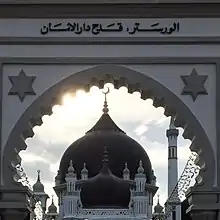
Zahir Mosque (Masjid Zahir)[25] is the state mosque of Kedah and enjoys a royal history and patronage. Built in 1912, its official opening ceremony was held on 15 October 1915 by the late Sultan Abdul Hamid Halim Shah. The architecture of the mosque was inspired by the Azizi Mosque[26] in Tanjung Pura, Langkat Sultanate (present-day North Sumatra).
Wat Nikrodharam is a significant Buddhist shrine in the city. It is located at Jalan Teluk Wan Jah, next to the city's primary roundabout. Its architecture reflects strong Thai elements with minor Chinese motifs. It offers a quiet oasis in the city centre. Both Theravada and Mahayana Buddhist traditions are observed here.[27]
Education
- Kolej Universiti Insaniah[28] (KUIN, formerly known as Kolej Insaniah or INSANIAH), located in Mergong.
- Albukhary International University (AIU), a new private institution of higher learning located in the Albukhary Complex.[29]
Other institutions of higher learning in Alor Setar include Open University (opposite PNB), Nursing College (Kolej Kejururawatan), Institut Kemahiran Mara (Tongkang Yard), Kolej Poly-Tech MARA at Jalan Putra, and Kolej Tentera Udara (Royal Air Force College) located in Kepala Batas.
Alor Setar is served by many primary and secondary schools. Notable secondary schools include:
- Sekolah Menengah Sultanah Asma
- Jalan Langgar

- Kolej Sultan Abdul Hamid
- Keat Hwa Secondary School
- Maktab Mahmud Alor Setar[30]
- Sekolah Menengah Teknik Alor Setar, technical school
Sports
Alor Setar has many sport facilities that are open to the public.
Darulaman Stadium is located in Jalan Stadium and Lebuhraya Darul Aman. It is used mostly for football matches and is the official stadium for Malaysian Super League's club Kedah FA. The stadium was built in 1967 and has a capacity of 32,387 following expansion in 1997. It was one of the venues for the 1997 FIFA World Youth Championship.
Other facilities are Sultan Abdul Halim Stadium, Pusat Akuatik Alor Setar, Kompleks Belia and Sukan.
Kedah hosted the Sukma Games in 2006.
Transportation
The capital of Kedah is connected to all parts of Peninsular Malaysia by all transport modes.
Road
The North–South Expressway, which extends from Bukit Kayu Hitam (Malaysia–Thai border town) to Singapore, has made it easy to drive to Kedah. It is a 6–7-hour drive from Kuala Lumpur and 1.5-hour drive from Penang via expressway.
Alor Setar is approached from the east coast via East–West Highway (Lebuhraya Timur Barat). Towns such as Butterworth and Kangar etc., can also be accessed from Alor Setar. Car rental services are available.
Bus
Most of bus companies in Peninsular Malaysia provide air-conditioned express bus services. Tickets can be bought at bus terminals or ticket offices. All buses that arrive in Alor Setar stop at Shahab Perdana Terminal Bus. Those who wish to travel to other towns, including Thailand, can board their bus at this terminal. Local bus services are also available, serving almost all towns in Kedah.
Rail
Train services are provided by Keretapi Tanah Melayu Berhad (KTMB) through their ETS services. Train are available between Alor Setar and Kuala Lumpur, Butterworth, Padang Besar, and Gemas. The city' two railway stations are Alor Setar railway station and Anak Bukit railway station. Tickets can be obtained from the train station or online booking.
Air
The Sultan Abdul Halim Airport (Alor Setar Airport, IATA code: AOR) is located at Kepala Batas, 15 km (9.3 mi) north of the city. It serves mostly domestic flights. Malaysia Airlines, Firefly, Malindo Air, and AirAsia fly daily to and from Alor Setar and Kuala Lumpur. Since 9 September 2013, Malaysian Airline System connects Alor Setar with a direct flight to Madinah and Jeddah for the Hajj season.
Sea
Passenger ferry services to and from Langkawi to Kuah Ferry Service are provided at Jeti Kuala Kedah, Alor Setar. The jetty is located 15 km (9.3 mi) west of the city. Travellers can take bus or taxi from city to the jetty.
Notable people from Alor Setar
Arts
- Singers: Yunalis Zarai, Shanon Shah
- Actors: Bront Palarae, Angelica Lee, Farid Kamil
- Writers and Arts: Dato' Abdullah Hussain, Dato' Shahnon Ahmad
Sports
Dato' Paduka Ahmad Basri Akil, Mohd Helmi Eliza Elias, Mohd Khyril Muhymeen Zambri, Tan Boon Heong
Government and politics
- Politicians:
- Tunku Abdul Rahman, first Prime Minister of Malaysia, 1957–70
- Tun Mahathir bin Mohamad, fourth and seventh Prime Minister of Malaysia, 1981-2003 and 2018–20
- Tun Daim Zainuddin, Finance Minister 1984-91
- Dato' Fadzil Noor, PAS President 1989–2002,
- Selvaakumaran Subramaniam
- Judiciary:
Tan Sri Zaki Tun Azmi, Tun Ahmad Fairuz Abdul Halim, Tun Mohamed Azmi Mohamed, Tun Syed Sheh Hassan Barakbah
Businessmen
Developments



According to the Ninth Malaysia Plan, by the year 2010, Bandar Muadzam Shah in Anak Bukit will become the new Administrative Centre after Alor Setar city. Bandar Muadzam Shah (Anak Bukit) is going through major infrastructure development, including the new Anak Bukit police station, new National Registration Department (Jabatan Pendaftaran Negara) of Kedah and also new state government buildings. A new railway station (Anak Bukit International Rail Station) is to be built there when the electrified twin-railway project is completed.
References
- "Key Summary Statistics For Local Authority Areas, Malaysia 2010" (PDF). Department of Statistics, Malaysia. Archived from the original (PDF) on 5 February 2015. Retrieved 19 April 2012.
- Majid, Embun (15 January 2009). "Archives | The Star Online". Thestar.com.my. Archived from the original on 17 April 2009. Retrieved 27 September 2013.
- Information, Malaya Department of (1957). Fact Sheets on the Federation of Malaya. The Department.
- Atiyah, Jeremy (2002). Southeast Asia. Rough Guides. ISBN 978-1-85828-893-2.
- primuscoreadmin (12 August 2015). "Message from Mayor". Official Portal of Alor Setar City Council (MBAS) (in Malay). Retrieved 24 December 2020.
- "Tunku Abdul Rahman Putra Alhaj | prime minister of Malaysia". Encyclopedia Britannica. Retrieved 23 December 2020.
- "Mahathir bin Mohamad | Facts & Biography". Encyclopedia Britannica. Retrieved 23 December 2020.
- (in Malay) 15/01/2009, Alor Star kembali ke Alor Setar, © Utusan Melayu (M) Bhd
- "Background of Alor Setar". ALOR SETAR'S EARLY HISTORY. Alor Setar City Council. Archived from the original on 17 July 2011. Retrieved 29 April 2011.
- Cayron, Jun G. (2006). Stringing the Past: An Archaeological Understanding of Early Southeast Asian Glass Bead Trade. UP Press. ISBN 978-971-542-506-3.
- July 31, Laurie Sams 9sc on; 2016. "Hat Yai, Thailand to Alor Setar, Malaysia". The Long Ride Home. Retrieved 23 December 2020.CS1 maint: numeric names: authors list (link)
- "Queen with a common touch | The Star". www.thestar.com.my. Retrieved 23 December 2020.
- primuscoreadmin (15 October 2015). "Info Alor Setar". Portal Rasmi Majlis Bandaraya Alor Setar (MBAS) (in Malay). Retrieved 2 July 2018.
- Melissa Darlyne Chow (13 October 2015). "Alor Star a rising star". New Straits Times.
- "World Weather Information Service – Alor Setar". World Meteorological Organisation. Retrieved 8 May 2014.
- "Total population by ethic group, Local Authority area and state, Malaysia, 2010" (PDF). Statistics.gov.my. Archived from the original (PDF) on 14 November 2012. Retrieved 10 December 2013.
- "Balai Besar, Alor Setar, Kedah, Malaysia". Asiaexplorers.com. 20 February 1959. Archived from the original on 1 October 2013. Retrieved 10 December 2013.
- "Alor Setar - Attractions | Attractions | Wonderful Malaysia". www.wonderfulmalaysia.com. Retrieved 24 December 2020.
- Ying, Teoh Pei (26 May 2019). "'Kuala Kedah re-energises my soul' | New Straits Times". NST Online. Retrieved 24 December 2020.
- "Kedah Paddy Museum – Muzium Padi". Malaysia-traveller.com. Retrieved 27 September 2013.
- "The Paddy Museum". Tourism Malaysia. Archived from the original on 27 May 2014. Retrieved 26 May 2014.
- "Mahathir's Birthplace or 'Rumah Kelahiran Mahathir'". Tourism Malaysia. Archived from the original on 27 May 2014. Retrieved 26 May 2014.
- "Independence House – Arkib Negara Malaysia". Arkib.gov.my. 7 June 1966. Archived from the original on 24 December 2013. Retrieved 27 September 2013.
- "10 Most Beautiful Mosques in the World". wonderslist.com. 12 July 2013. Retrieved 3 November 2014.
- "Beranda Brandan: Mesjid Azizi, Bukti Kejayaan Kesultanan Langkat". Brandanese.blogspot.com. Retrieved 10 December 2013.
- "soleilian.com". soleilian.com. Retrieved 10 December 2013.
- Archived 25 December 2012 at the Wayback Machine
- Archived 13 March 2012 at the Wayback Machine
- "Portal Rasmi". LMM. Retrieved 27 September 2013.
https://www.nst.com.my/news/2015/10/alor-star-rising-star[1]
External links
| Wikimedia Commons has media related to Alor Setar. |
 Alor Setar travel guide from Wikivoyage
Alor Setar travel guide from Wikivoyage- Towns and Cities in Malaysia
| Preceded by Kulim |
Capital of Kedah (1901-present) |
Succeeded by present |
- "Alor Star a rising star | New Straits Times". 13 October 2015.





